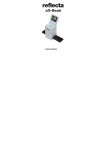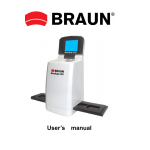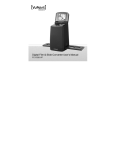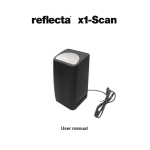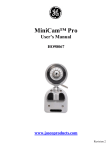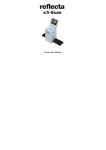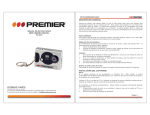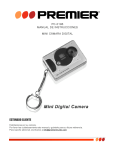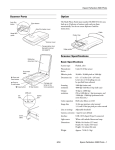Download Reflecta Film S1-scan
Transcript
User manual For customers in North and South America For customers in USA This device complies with Part 15 of the FCC rules. Operation is subject to the following two conditions: (1) This device may not cause harmful interference. (2) This device must accept any interference received, including interference that may cause undesired operation. For customers in Canada This Class B digital apparatus meets all requirements of the Canadian Interference-Causing Equipment Regulations. For customers in Europe “CE” mark indicates that this product complies with the European requirements for safety, health, environment and customer protection. “CE” mark cameras are intended for sales in Europe. 1 1. System Requirements • Personal computer, laptop, desktop or IBM compatible with Pentium 166 MHz minimum, and with an active USB (Universal Serial Bus) port. • Windows 2000 / XP / Vista / Windows 7, CD ROM drive, color monitor, mouse and keyboard. 2. Package Contents Make sure that all of the items shown below are included. - Film Scanner - USB cable - CD-ROM for Arcsoft Software - User’s Manual - TV cable - Adapter - Positive Slide Holder - Negative Film Holder - Cleaning Brush 2 3. Name of parts We strongly suggest using a clean, dry, non-alcohol cotton swab to insert into the film scanner slot and clean the glass surface periodically to produce a clear image. Please make sure your film, slide and holder are clean before inserting into the scanner as well. Dust or dirt on the film, slide and holder will affect the quality of your scanned images. 3 4 How to install slides and film into the tray holder a. Open the film holder as illustrated b. Put a film/slide in the film/slide slot as shown. Note: Do not flip the film/slide. If flipped, the pictures will be scanned backwards. c. Close the film/slide holder 4 5. Insert and take out SD card (optional ) • Insert SD card before scanning. •Built in memory will be suspended when the SD card is in use. • Please close and then open the cover after card inserted. Note: This device does not support hot-plug. Inserting SD card during operation will cause the device power off. 6. Quick Start Connect to the AC power source to turn on the device. Open the upper cover and you can see the power LED light will become red. Insert the SD card into the SD card slot. Insert the slide or film tray into the scanner and move the tray carefully to adjust the film. Press the Start button to capture a picture Power On/Off: • Power On: Open the upper cover and you can see the power LED light will become red. • Power Off: Close the upper cover. Select Function • Press the Function button to enter function mode. You can see the icon on the screen. Press the Left or Right buttons to select function. 5 • Select Home Press Start button to back to capture mode. • Scanning Type To enter the Film Type, you can use the Left or Right button to select, press the Start button to confirm. Slide: You need select the Slide mode when you scanner the slide. Monochrome: You need select the Monochrome mode when you scanner the BW film. Film: You need select the Film mode when you scanner the color film. • Resolution To enter the Resolution Function, you can use the Left or Right button to select, press the Start button to confirm. 1800 DPI --2592 x 1680 Pixels 3600 DPI – 5184 x 3360 Pixels • Format To enter the Format, to select ‘ do not format’ (X) or ‘ format’ (√), press the Start button to confirm. Caution: Formatted files cannot be recovered. • TV Output Connect the scanner to your TV with TV cable. NTSC: Setting the TV Output to NTSC. PAL: Setting the TV Output to PAL. 6 • Exposure value To enter the EV mode, press the Left or Right button to select, and press Start button to confirm. Exposure compensation helps you change the exposure setting manually to adjust object lighting. This feature helps to achieve better results when scanning a film or slide image with a strong backlight, or an image that is against a dark background. • The settings can be adjusted in 1/2 steps within the range –2EV ~ +2EV. • You can check the result of the compensation by viewing the image on the screen panel. • Mirror Press the Left or Right buttons to select the icon on the screen, and press Start button to confirm. Press Start button to capture the picture again. Playback Press the Playback button to enter playback mode, and view the scanned photos. Press Left or Right button to select the next / previous photo. Playback Menu Press the Start/Playback Menu button to enter the menu mode You can see the icons on the screen Press the Left or Right buttons to select these items 7 • Single When you select the icon, press Start button to confirm. You need press Left or Right button to review the next / previous picture. • Slide Show Use the Slide Show feature to continue display your photos on the scanner screen panel. Once selected the Slide Show Mode, camera will automatically play all the photos. Press any button to stop the slide show. • Delete One Select the to delete current image. • Delete All Select the icon will delete all the stored images from the internal memory or SD card. Files that are erased cannot be recovered. Make sure you select the image you want to delete. • Rotate 90 ∘(Left) Select the icon, the current image will rotate 90∘by counter clockwise direction.. • Rotate 90 ∘(Right) Select the icon, the current image will rotate 90∘clockwise direction. 8 • Copy Select the icon, and press Start button to confirm copy all images into SD card from internal memory. • Exit Select the icon, and press Start button to confirm, then you will back the playback mode. 7. Downloading Images to Your Computer For Windows 98/ME: When connected the scanner to the computer with the USB cable, the “USB Mass Storage driver” appears on the computer screen. For Windows 2000 Double click on “My computer”, and then double click on Removable Disk (i:) in the DCIM files. (All the photos and videos are stored here). For Windows XP: A dialogue box with options appears as shown on the Right side. The options are Play, Find/Fix/Share Images. Open folders to View files/Take no action, /Copy images to a folder on My computer/View a slide show of images,and etc. Please select one of them and click on “OK”. 9 For Vista / Windows 7: The dialog box of the removable disk will be pop-up when you connect to the USB port Please choose the “Open folder to view files” to view the images Vista: Windows 7 : 8. Installing the software • Installing the software 1. Insert the installation CD into the CD-ROM drive and the installation CD menu should appear. 2. When you see the following screen, choose “Arcsoft Software Suite” to install the software. Windows 2000 / XP / Vista/Windows7 directions: 1. Select the language you wish to be 2. PhotoImpression will start the installation. displayed. Then click OK 10 3. Click on Yes to agree to the terms and 4. Click Next to have PhotoImpressions conditions. download into your Programs folder. 5. Click Next to continue. 6. PhotoImpressions will start the setup process. 11 7. Once you get this to this screen select 8. Click on Finish to complete and restart the "Clear All" so that PhotoImpressions does computer. not take over the files on your computer. 9. The installed software will automatically create a “PhotoImpression 6” logo on your desktop. Restart the computer and remove the installation disk. Note: If a “Code 10 error” appears on your screen when using the program, please do not unplug your device from the USB port of your computer. Please restart your computer and resume running the PhotoImpression program. 12 9. Now you can start to edit the picture as you like: First , click on the “PhotoImpression 6” icon on the desktop. Follow the instructions to open the software, and click on the picture to select, then use the Arcsoft tools to edit the pictures. Main Menu The Main Menu appears in the upper left corner of the workspace many of the program's key options and controls are available in the Main Menu. To learn more about a particular menu item and the options and controls it contains, choose from the list below: File Scan for Media Files Launches the Scan for Media Files dialog box that enables you to scan your computer for all photos, music and video files. This process creates a media library that helps the program perform as fast as possible. You can scan your computer in one of the following three ways: 13 • • • Scan Primary Folders Only - Scans folders most commonly used for storing media, such as My Documents, My Pictures and Desktop. Scan All Folders - Scans your entire computer for media (except Windows and Program Files folders). Select the folders you want to scan –Let you choose the folders for scanning. View Full Screen/Play (F4) Plays or displays the first selected file in full screen view. Main Buttons Get Photos Acquire from Scanner Here you can: • Acquire images from connected TWAIN compliant devices such as scanners and some digital cameras. 14 • Assign names to image files as they are acquired (using today's date or a descriptive word). How to acquire images from a TWAIN compliant device: 1. 2. 3. 4. 5. Select a scanner or other TWAIN device from the drop down list. Choose the file format you want to use for the acquired images (JPG). If you've selected JPG as the file format, select the image quality for the acquired images (Highest, High, Normal, Low). The lower the quality selected, the higher the level of compression applied. Choose a destination folder for the photos by clicking "Browse" (folder icon) and navigating to the folder. Choose a naming method (today's date or description). Enter a description if applicable. Click "Acquire". Edit Photo Editing Tools The Photo Editing Tools module includes a complete set photo enhancement, editing and retouching controls. The window can be stretched to provide a large size view of the active photo. Double click the module's tool bar to maximize the window to fill the computer screen. 15 In addition to the large photo workspace, the Photo Editing Tools module includes five distinct sets of controls: Enhance The Enhance function includes two types of controls: Auto Enhance Click "Auto Enhance" button to improve the overall quality of your pictures with a single click. Manual Fix For precise image enhancement control, adjust the Brightness, Contrast and Sharpen sliders. How to enhance a photo manually: 1. Move the sliders to adjust the level of Brightness and Contrast and to make the image more Sharp. 2. Use the zoom slider to get a closer look at how the adjustment affects the photo. 3. Click "Apply" if you like the result. Click "Cancel" if you do not. Color This feature is designed to fix digital photos that have unnatural color or appear to dark. It's also great for fixing scanned versions of old prints that have faded or whose colors have changed after many years of neglect. 16 How to fix the color of a photo: 1. 2. 3. Drag the color balance sliders to make the photo color appear more natural. Add red or yellow to make the photo warmer. Add blue or green to make the photo cooler. Drag the Lighter/Darker slider to the left to reveal details hidden in a dark photo or to the right to make a faded photo look new again. Click "Apply" if you like the result. Click "Cancel" if you do not. Red-Eye This feature makes it easy for you to fix all red eye - a common problem in flash photography. There are two ways to fix redeye: Auto Fix 1. Simply click the "Fix Red-Eye" button to automatically find and fix all red-eye. 2. If not all of the redeye is fixed, used the "Click to Fix" method. Manual Fix 1. Use the zoom slider on the toolbar to zoom in on the photo. 2. Drag the small white box inside the zoom navigator to move over a red eye. 3. Place your cursor directly over the red eye and click. 17 4. Repeat the process until all red eyes are fixed. 5. Click "Undo" if you make a mistake or don't like the result. Crop This feature enables you to trim photos for dramatic effect or cut off the ugly/distracting parts of a picture. How to use crop: 1. 2. 3. 4. 5. 6. Choose the crop orientation (portrait or landscape). Select a fixed proportion for the crop rectangle (4:6, 5:7, 8:10) or choose "Custom" if you want to use another proportion. Resize the crop rectangle by clicking and dragging the red lines. Move the crop rectangle into position by clicking and dragging inside the red box. Click "Crop". The area inside the rectangle will be kept, the area outside will be trimmed away. Click "Undo" if you make a mistake or don't like the result. Straighten This feature enables you to fix photos that appear to be tilted. How to use Straighten: 1. 2. 3. Move the slider (or click the rotate buttons) until the photo appears straight. Use the superimposed grid lines for vertical and horizontal reference. Click "Apply" if you like the result. Click "Cancel" if you do not. 18 Blur Background This feature can be used in a subtle way -- to tone down un-important background details, or for dramatic effect -- by making the main subject of a photo pop out of the picture. How to use Blur Background: 1. With your cursor, trace a line around the person or object you want to stand out. When you release the mouse button, the area outside the traced line will become slightly blurred. Drag the first slider to make the transition between the blurred and non-blurred area sharp or smooth. Drag the second slider to increase or decrease the amount of blur. Click "Apply" if you like the result. Click "Cancel" if you do not. 2. 3. 4. Saving Your Results When you're done editing a photo, click Save As to save your results. You can choose to overwrite the original file or save a new one. Click "Close" to exit the Photo Editing module. Retouch Healing Brush The Healing Brush is good for fixing dust, scratches and removing skin blemishes. How to use the Healing Brush to fix a skin blemish: 1. Establish a source point for the Healing Brush by holding the Shift key and clicking on an area of the skin that is close in color and texture to the area you want to heal. 19 2. 3. 4. Use the zoom control to zoom in on the blemish. Adjust the size of the healing brush so the cursor (circle) is only slightly larger than the blemish. Paint over the blemish. The area will be healed. Click "Undo" if you make a mistake or don't like the result. Clone The Clone tool is good for removing unwanted elements from a photo. It can also be used for fun effect, like moving a nose from one person to another. How to use the Clone tool to remove a telephone pole from the background of a photo: 1. 2. 3. Establish a source point for the Clone tool by holding the Shift key and clicking on an area of the sky that you want to use to paint over the telephone pole. Adjust the brush size so the cursor (circle) is only slightly larger than the widest part of the telephone pole. Click and hold your mouse button and carefully paint over the telephone pole. Do not release the mouse button until the job is done. The sky will be cloned into place. Click "Undo" if you make a mistake or don't like the result. Lighten/Darken The Lighten/Darken tool is good for adjusting specific areas of a photo. Smudge Simulate the smearing of wet paint. Please click and drag the sliders below to change the brush size and hardness. 20 Sharpen Sharpen blurry areas. Please click and drag the sliders below to change the brush size and transparency. Blur Smooth out rough areas. Please click and drag the sliders below to change the brush size and intensity. Paint Brush Let you "paint" on your image when you click and drag the mouse. Please click and drag the sliders below to change the brush size and transparency. Line Draw a straight line in the photo. Please click and drag the sliders below to change the line width and transparency. Eraser Simulate an eraser, removing the image painting by paintbrush and line tools from your photo. Please click and drag the sliders below to change the eraser size and effect. Saving You Results When you're done, click "Save As" button to save your results. You can overwrite the original file or save it as a new one. Or click "Cancel" to exit without saving. Click "Close" to exit the Photo Editing Module. Note: For more detailed information, please refer to the [Help] of the program. 21 10.Specification Interface: USB 1.1 Image Sensor: 5 mega CMOS sensor Lens: F no.= 5.0, 2 G + 2 P Panel 2.4" TFT Focus Range: Fixed focus Exposure Control: Automatic / Manual (-2.0 EV~ +2.0EV) Color Balance: Automatic Scan high resolution 1,800 dpi = 2520 * 1680 Data Conversion 3,600 dpi = 5040 * 3360 10 bits per color channel Film type 35mm Negative , Monochrome , Slide Scan Method Single pass Light Source Back light (3 white LED) Button Left, Right ,Start TV OUT YES ( NTSC / PAL) Storage Built-in 32 MB Nand Flash + SD card Slot Power: DC 5V (Adapter included) USB MODE Mass storage Dimensions 101*94*96mm Weight 370g Software Operation Systems Arcsoft Photo Impression 6(included)for Win XP,Vista 32/64,Win7 Win98(Driver needed),Win ME/2000 / XP ,Vista32 /64, Win7,Mac10.4 22























